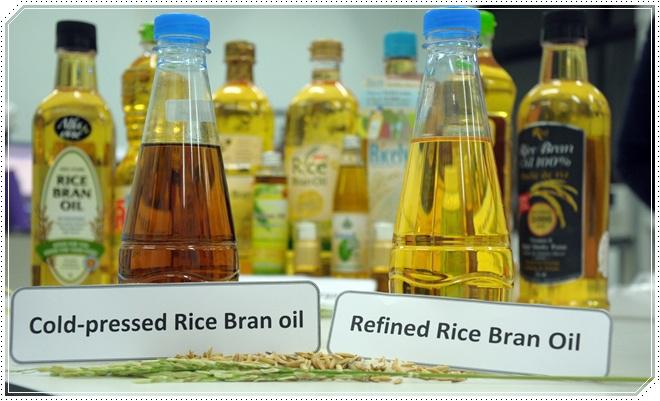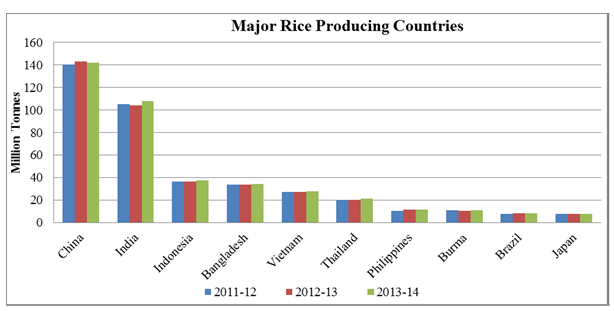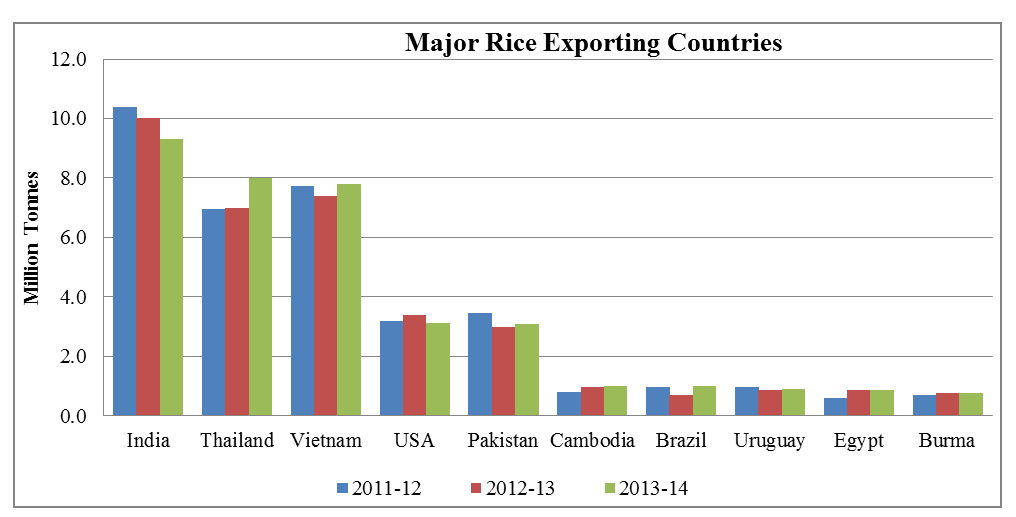|
|
|
You can get e-magazine links on WhatsApp. Click here
|
|
|
|
|
|
Future Edible Oil of India: Rice Bran Oil -“The wonder Oil”
|
|
Friday, 16 October, 2015, 08 : 00 AM [IST]
|
|
Khalid Muzaffar, Yogita and Gulzar Ahmad Nayik
|
A unique vegetable oil rich in antioxidants produced from the outer layer of rice, during the polishing process of the rice, is what is popularly known and consumed as Rice Bran oil (RBO).
Studies around the globe have confirmed the cholesterol lowering properties of this oil due to presence of unique nutraceuticals - oryzanol & tocotrienols - in it.
Crude rice bran oil is mainly composed of 81.3-84.3% triglycerides, 2-3% diglycerides, 5-6% monoglycerides, 2-3% free fatty acids, 0.3% waxes, 0.8% glycolipids, 1.6% phospholipids, 4% unsaponifiables. RBO is extensively used in most Asian countries viz. Japan, Korea, China, Taiwan and Thailand as premium edible oil. It is the conventional & favourite cooking medium of the Japanese and is popularly known as "Heart Oil" in Japan. It has acquired the status of a "functional food" or a "health food" in Western countries. As per the Cardiologists’ Society of India, 30% of India's population is prone to cardiac problems. Since every 1% reduction in Cholesterol, reduces the risk of heart attack by 2%, Rice Bran Oil can become a boon for the people. RBO will give better realisation of paddy to Indian farmers.
Characteristics that make it better cooking oil
- Most ideal fat composition.
- Rice Bran Oil is an excellent alternative for those who have intolerance to other cooking oils because of its hypoallergenic effect.
- Rice Barn Oil has a very high smoke (burn) point, making it perfect for deep frying, pan or stirs frying.
- Rice Bran Oil creates less polymers (or is less greasy) than other oils meaning better flavour and easier clean-up.
- Food cooked with RBO absorbs up to 15% to 20% less oil. This unique property of less oil absorbing and light viscosity results in reduced calories, better tasting food, economical and enhanced flavour and palatability.
- RBO has excellent oxidation stability.
High content of natural antioxidants present in rice bran oil, impart higher oxidative stability and a longer shelf life as compared to other edible oils. The oxidative stability of refined rice bran oil has been found to be five times more than the groundnut oil. Although the polyunsaturated fatty acid content of rice bran oil is much lower than the other conventional oils, it has higher cholesterol reduction power than even the polyunsaturated fatty acid rich oils. The best thing about RBO is that it retains its high antioxidant property at high temperature as well.
Health Benefits
- Rice Bran Oil contains a good amount of oryzanol (antioxidant) that possesses cholesterol lowering properties, thus reducing blood cholesterol, as well as blood clotting by retarding platelets aggregation.
- It also helps to reduce triglycerides and improves the good cholesterol to bad cholesterol ratio (HDL/LDL) which is very important for heart health.
- As discussed earlier, Rice Bran Oil has a balanced fatty acid profile as recommended by the World Health Organization (WHO), American Heart Association’s (AHA), the National Institute of Nutrition (NIN) and the Indian Council of Medical Research (ICMR).
Rice Bran Oil is composed of antioxidants like oryzanol, tocotrienol, tocopherol, squalene as compared to other edible oils. This essentially results in health benefits like
Better skin: Squalene softens the skin as it is a natural moisturiser. This effectively helps delay wrinkle formation and protects the skin from sun damage and maintains a healthy skin tone.
Enhances the immune system: Due to its high antioxidant content, it fights the free radicals that harm the immune system thereby protecting the body from disease. Besides benefiting the lipid profile, oryzanol also has anti-dandruff and anti-ageing properties.
Helps prevent cancer: Rice Bran Oil is rich in tocopherol and tocotrienols (vitamin E) which are powerful antioxidants. These are anti-mutagenic elements that curb the cancer-causing free radicals thereby reducing cancer risk. Until recent times the health aspects of Rice Bran Oil have not been adequately highlighted. It is important for people to know that Rice Bran Oil has not only cholesterol lowering properties but also has anti-viral, anti-itching and anti-cancer effects.
Nervous system and endocrine health: The antioxidants found in Rice Bran Oil also benefit the nervous system. Vitamin E helps improve neurological functioning and balances the endocrine hormones.
Processing of Rice Bran Oil
RBO in native form when extracted is not readily useable for cooking due to some waxes and free fatty acids that tend to burn and smoke when heated. Thus oil has to be refined to make it acceptable for daily cooking purposes. It needs to be carefully processed without use of chemicals to retain its valuable nutrients – including Oryzanol – even while the unwanted materials are removed from it.

Production, Import and Export of RBO
During 2012-13 and 2013-14, the world rice production has increased by 1% (from 472 million tonne to 476 million tonne), trade by 8% (from 38 million MT to 41 million MT) and consumption by 3% (from 469 million MT to 481 million MT).



Rice production is estimated to be 88.02 million tonne in 2014, four per cent less than last year's figure, the agriculture ministry's latest data showed. Production of RBO holds immense potential in India considering the surge in paddy production at 150 million tonne over the last 10 years. According to the Solvent Extractors Association (SEA) of India, the rice bran oil production in the country is currently at 9 lakh tonne against the potential of 14.6 lakh tonne i.e. 75% of total global production of 1.2 million tonne. India is leading producer of RBO followed by Japan, Thailand and China. Out of 9 lakh tonne of oil produced in India, only 3 lakh tonne is consumed as edible while rest is blended with other oils or used by vanaspati industry. As per SEA data, India RBO production is tremendously increasing annually. If the demand increases there is much more expectation in production increase of RBO. In last five years there has been an increase of 20-30% in RBO consumption. Asian countries like Thailand and Japan have showed much more interest. In 1964, the first rice bran processing plant was set up in Andhra Pradesh followed by states of Punjab, Haryana and West Bengal.
Suggested labels for nutritional information
Under notification No. G.S.R. 664(E) dated Sept 19, 2008
| Nutritional Information (Per 100 g) |
| Energy |
900 kcal |
| Protein |
0 g |
| Carbohydrate |
0 g |
| Sugar |
0 g |
| Saturated Fatty Acids |
24 g |
| Polyunsaturated Fatty Acids |
34 g |
| Monounsaturated Fatty Acids |
42 g |
| Trans Fatty Acids |
0 g |
| Cholesterol |
0 mg |
| Vitamin E |
50 mg |
| Oryzanol |
1000 mg |
As per Codex standards the relative density of RBO should be 0.910-0.929, refractive index 1.467-1.470, Saponification value 180-199 and Iodine value should be 136-148.
Future Scenario
1.The state as well as Central government, NGOs and other private organisations need to identify and explore more utilisation of RBO.
2.Awareness about health benefits of Rice Bran Oil among people has to be created by doctors, dieticians, cardiologists, nutritionists and health advisors.
3.Associations and organisations like Asian Society of Rice Bran Oil, International Council of Rice Bran Oil, Solvent Extractors Association of India and International Association of Rice Bran Oil should frequently update on RBO benefits and statistics.
(The authors are research scholars at department of food engineering and technology, SLIET, Punjab. They can be contacted at gulzarnaik@gmail.com or khalidmuzaffar76@gmail.com)
|
|
|
|
|
|
|
|
|
|